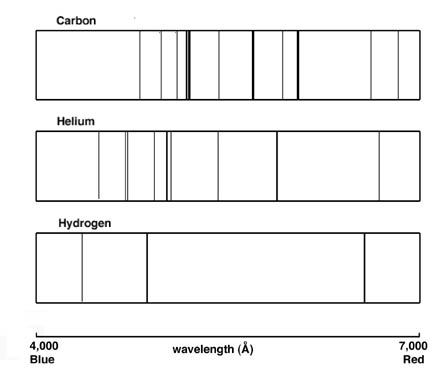What is Your Cosmic Connection to the Elements?
|
Nickel-odeon
(By Shirley Burris, Bayview Community School, Mahone Bay, Nova Scotia)
This activity provides an auditory experience of the spectra of different elements. It can be done with other classroom experiences of atomic spectra to provide another means for students to distinguish the differences in the spectra.
Using colored paper, or a color print image of the colors in a rainbow, create a spectrum with the full range of optical colors. Cut this spectrum into strips, with each strip a slightly separate shade from its neighbor. Place these strips, one at a time, on the keys of a musical keyboard. The colors of the optical spectrum are now mapped onto the musical keys.
Now examine the line spectra of two or three elements. Below are the spectra for hydrogen, helium and carbon. Note the location of the lines in the spectrum. What do these lines represent? Why do different elements have a different pattern of lines?

For each spectrum, use strips of black paper to represent the spectral lines. Place these strips on the piano keys in the same position as in the spectrum for the element. Now, "play" the chord that results from the markings, and "listen" to the element.

|
| An example of the placement of the lines of hydrogen on a piano keyboard. The keys marked with "X" are to be played. |
How is this model different from the true patterns of emission from the elements?
(Color illustrations for this activity, and a full color spectrum to use on the keyboard, are available at http://imagine.gsfc.nasa.gov/educators/elements/.)





